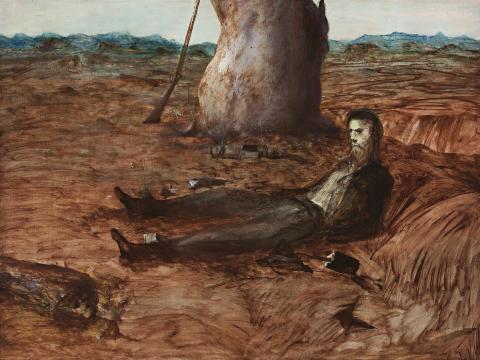BURKE LAY DYING, 1950
SIDNEY NOLAN
oil and enamel paint on composition board
91.5 x 122.0 cm
signed and dated lower left: Nolan / July 50
Lord McAlpine of West Green, United Kingdom
Art Gallery of New South Wales, Sydney, a gift from the above in 1995 (label attached verso)
Sotheby’s, Sydney, 26 November 2007, lot 82
Gould collection, Melbourne
Burke and Wills: from Melbourne to myth, National Library of Australia, Canberra, 27 March – 2 June 2002, cat. 86
The Director’s Choice 2009, Gould Galleries, Melbourne, 7 May – 13 June 2009, cat. 6 (illus. in exhibition catalogue)
The Director’s Choice 2012, Gould Galleries, Melbourne, 19 July – 31 August 2012, cat. 7 (illus. in exhibition catalogue)
Bonyhady, T., Burke and Wills: from Melbourne to myth, exhibition catalogue, National Library of Australia, Canberra, 2002, p. 46
The experience of Sidney Nolan’s extended visit to Central and North-west Australia in 1949 paved the way for an extraordinarily productive period in which he painted some of his most distinctively Australian pictures. During the trip, Nolan read about the Burke and Wills expedition, later writing ‘I doubt that I will ever forget my emotions when first flying over Central Australia and realising how much we painters and poets owe to our predecessors the explorers, with their frail bodies and superb willpower.’1
Between 1860 and 1861, Robert O’Hara Burke and William John Wills led a team of men on an epic journey during which they aimed to cross the Australian continent, travelling 5000 kilometres between Melbourne in the south and the Gulf of Carpentaria on the far north coast, discovering and documenting the unknown and unmapped centre of the country for the first time. While several members of the expedition reached the Gulf, only one of them survived to return to Melbourne and both Burke and Wills died on the journey. Like so many nineteenth century expeditions of discovery, theirs was a heroic tale of ambition and remarkable endurance ultimately marked by tragedy.
Nolan had found subjects for his work in stories of Australia’s history before, the best known being that of the infamous bushranger Ned Kelly who was the focus of a series painted in the mid-1940s (and again in the 1950s). As he had done with the Kelly theme, Nolan researched the story of Burke and Wills, reading widely in public libraries, studying historical photographs and newspaper illustrations, as well as experiencing the harshness and isolation of the desert landscape firsthand. Although he was interested in the details of the story, Nolan did not aim to illustrate it but sought instead to say something about the present by interpreting and re-presenting aspects of the past.
The Burke and Wills works were painted at the same time as the Central Australian series, the first pictures completed within two months of Nolan’s return from his inland travels. Finished in July 1950, Burke Lay Dying, 1950 was the second depiction of the ill-fated explorer2 who, realising that death was imminent, is reported to have asked a fellow member of the expedition to ‘place the pistol in my right hand and … leave me unburied as I lie.’ In the first painting Burke is dead and his body is beginning to merge with the landscape, but in this work Nolan forces the viewer to confront the humanity of his subject in an image of a man defeated. The extraordinary pathos of this image is emphasised by the delicacy of its depiction – the paint so lightly handled and burnished back to expose the white ground underneath that it appears almost translucent – and tiny yellow wildflowers shown growing in the ground around Burke, an optimistic symbol of life and regeneration.
1. Nolan, S. to Dutton, G., quoted in Dutton, G., ‘Sidney Nolan’s Burke and Wills Series’, Art and Australia, Sydney, Nolan Issue, 1967, p. 459
2. Perished, 1949, oil and enamel paint on composition board, 91.0 x 122.0 cm, The University of Western Australia Art Collection, Perth
KIRSTY GRANT
FORMER DIRECTOR OF HEIDE MUSEUM OF MODERN ART,
FORMER SENIOR CURATOR, NATIONAL GALLERY OF VICTORIA
